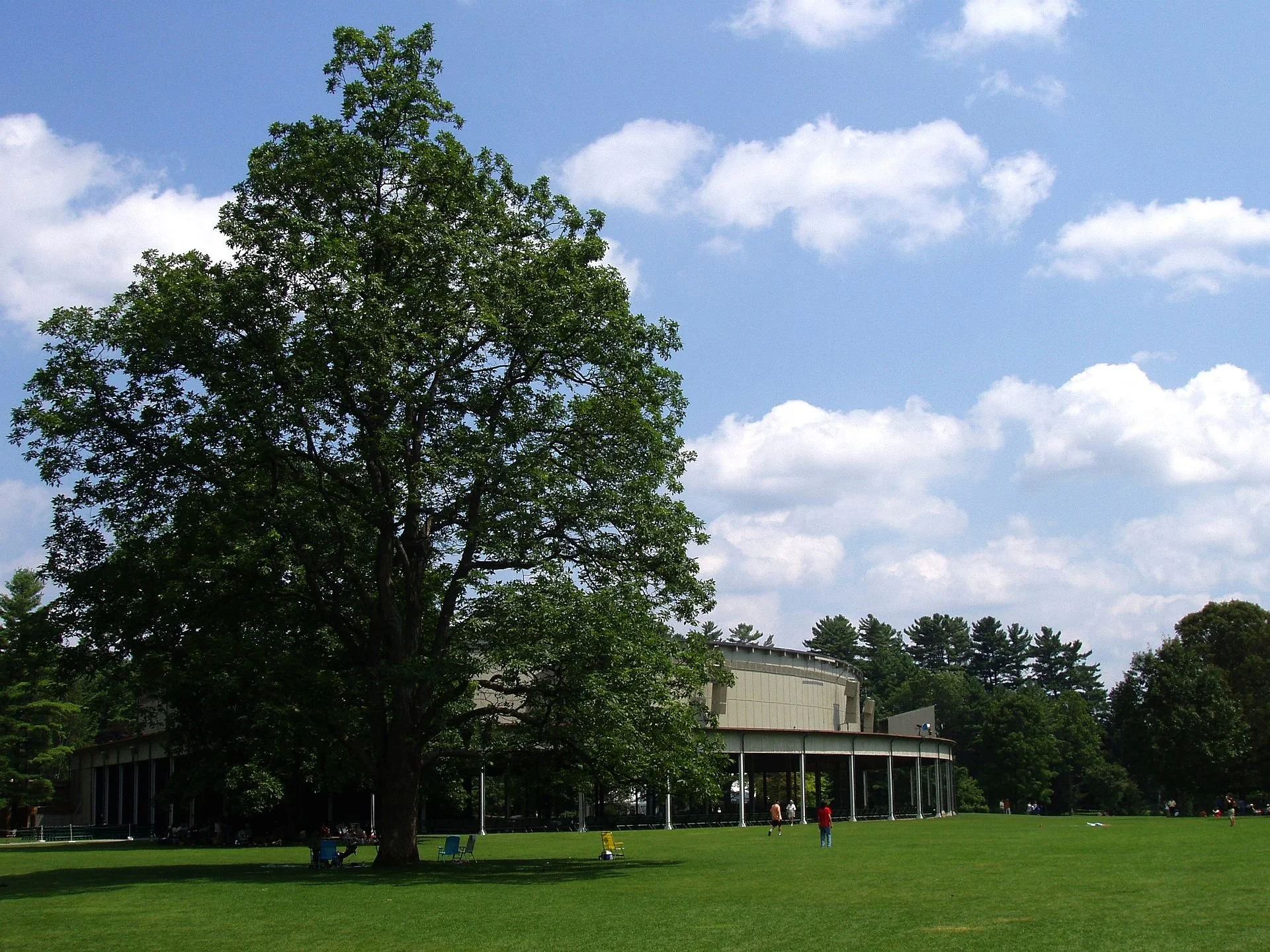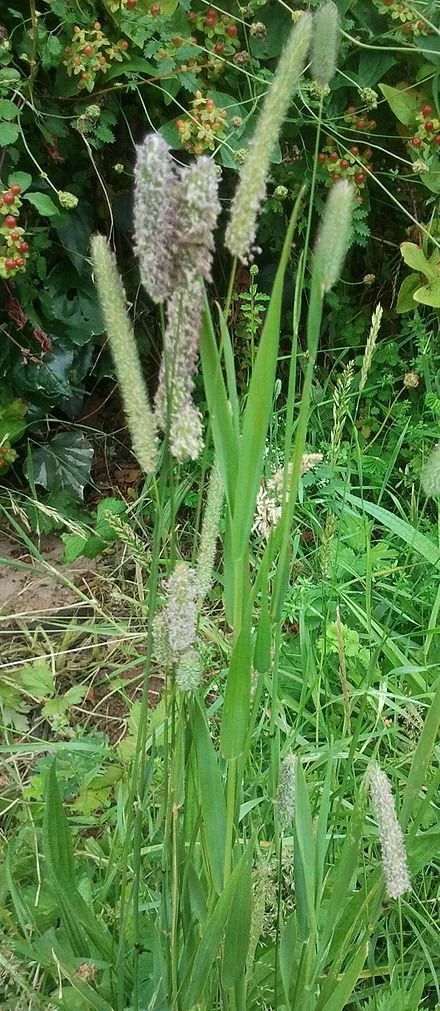Cynthia Drummond:New England lawns are changing with the times
Tanglewood Music Shed and lawn, in Lenox, Mass. Music lovers sit and recline on this famous lawn while listening to summer concerts of the Boston Symphony Orchestra
— Photo by Daderot
From ecoRI News (ecori.org)
RICHMOND, R.I. — Love them or hate them, lawns aren’t going to disappear from the New England landscape anytime soon. Caring for those islands of green can be as casual as an occasional mowing, or as involved as season-long programs that include watering, adding nutrients and eliminating weeds and insect pests.
University of Rhode Island Professor Bridget Ruemmele teaches several turf grass courses, including management and irrigation technology. Her research focus is turf grass improvement.
In drought-prone states such as Texas, where Ruemmele worked before coming to Rhode Island, many municipalities require homeowners to use xeriscaping, landscapes composed of plants that need much less water than traditional lawns.
Ruemmele said lawns remain popular in Rhode Island because they provide areas for recreation, and they are less likely to harbor ticks.
“One of the advantages, of course, of having at least some lawn near your buildings is, you don’t have to worry as much about deer ticks [which spread Lyme disease]. That’s the big issue,” she said.
Recent hot, dry summers have resulted in watering restrictions in many towns, leaving lawns brown and stressed and prompting calls to URI from homeowners asking what they can do to counteract the effects of drought.
“We tend to have fairly regular rainfalls, but when there are droughts, the years we have droughts are when people all of a sudden go ‘Oh, maybe I should be concerned about it,’ and that’s when we get more calls and requests for information,” Ruemmele said.
Some homeowners are taking a more radical approach and reducing the sizes of their lawns. Young people may not be as interested in lawn maintenance and older couples who no longer have children at home don’t need the recreation space.
“As people seem to be aging, they’re more interested in not having as big of a lawn area,” Ruemmele said. “Some of these people who are reducing their lawn are spending hours and hours every week maintaining the alternative plants they put in, so it very much depends upon what kind of plants you decide to put in whether or not you’re going to be saving time, because if you’ve got a lawn, essentially, mow it once a week.”
The most widely used turf grass species, Kentucky blue grass, is not considered to be drought-tolerant, although Ruemmele said the original blue grasses were much tougher than the varieties sold today.
“For years, people associated it with high maintenance and that’s because, back when we were less concerned about the environment, breeders developed grasses that responded to increased irrigation and increased fertility, whereas the more common types of Kentucky blue grasses…they are the ones that were adapted to whatever the environment threw at them, so they were able to tolerate periods of stress and that’s a major emphasis that turf breeders have gone back to.”
With nutrient runoff, much of it from fertilizers, polluting coastal waters, Ruemmele said municipalities are beginning to restrict outdoor water use as well as the types of fertilizers that homeowners can apply to their lawns.
“The emphasis is on, especially, not automatically applying a fertilizer, emphasizing that you’re going to be getting a test of your [turf] fertility every couple of years and then only applying the fertilizer that’s recommended,” she said.
As an example, Ruemmele cited the intensively marketed “four step” program, in which most of the steps are usually unnecessary.
“What I think about the four-step program, is that if you don’t have grubs, you don’t need that stuff, and if you keep a nice, healthy, dense turf, that’s going to be eliminating most of any perceived weed problems that you might have, and you can eliminate that step. And so basically, the step that has fertilizer only is about the only one you really need,” she said.
Dana Millar, of West Kingston, is known for his organic lawn care service, although his company, Dana Designs, also provides conventional services to homeowners who request them. Most of Millar’s clients still ask for conventional services, but an increasing number of customers, about 65 at last count, prefer organic methods.
Organic lawn care is based on the premise that healthy turf grass requires healthy soil, so rather than applying chemicals to the grass, Millar uses a bottom-up approach, building nutrients in the soil that support the grass.
“Top down, you’re applying materials and products over the top,” he said. “Organically, you are encouraging the health of the soil, so the soil feeds the plant.”
Millar believes that organically grown grass is not only stronger, but also more resistant to environmental stressors.
“Over the period of the last two years, we’ve had greater drought than anybody had in memory and in this past year, there was more rain than anybody had in memory,” he said. “Each one of those climate-driven events stressed lawns in different ways. My organic lawns were more resilient, so in the drought, they went into drought stress later and came out of drought stress more quickly, and lots of times, didn’t need much repair, whereas lawns that may have been conventional had a harder time and they weren’t able to fend off insects. They weren’t able to fend off diseases and their recovery, in some cases, wasn’t complete. The turf was damaged and had to be completely restored.”
One of Millar’s early mentors was Earth Care Farm founder Mike Merner, a believer in the benefits of compost and the importance of nurturing the microorganisms that live in soil and make it productive.
Millar always begins an organic program with testing and amending the soil, which can be a complicated process.
“We need to know what the state of the soil is, so every organic program begins with a soil test, and we ask more from a soil test than the conventional test, because we want to know organic matter, we want to know cation exchange capacity, we want to know not only the soil pH, but its resistance to change. …This determines the type and amount of amendments that we might need to improve soil and gives us a baseline for expectations and a budget over a period of time,” he said.
While lawn care products have traditionally been marketed to men, Millar said many of the clients of his organic service are women who have taken over the responsibility of lawn maintenance from their male partners.
“I have lots of women clients who are at a point in their lives where they have the discretionary income and the authority in their households to make decisions which are usually the males,’ ” he said. “‘How are we going to treat our lawn? Why are we going to do this? I want a garden, I want to feel safe and I want my grandchildren to have the freedom to enjoy our lawn.’”
Cynthia Drummond is an ecoRI News contributor.
Timothy grass, probably named after Timothy Hanson, an American farmer and agriculturalist said to have introduced it from New England to the South in the early 18th Century. European settlers introduced it into New England in the late 1600s and by 1711 it had become known as Herd’s grass, after John Herd, a Maine farmer who began to cultivate it.

